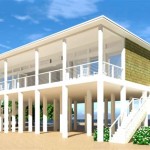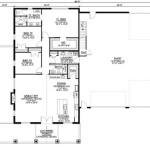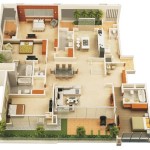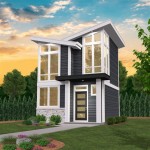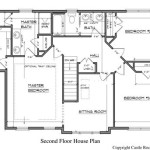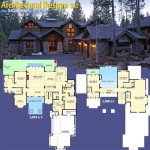3 Bedroom Modern House Plans: A Comprehensive Guide
The quest for an ideal dwelling often leads homeowners to explore various architectural styles and floor plans. Among the popular choices, 3-bedroom modern house plans stand out for their versatility, functionality, and aesthetic appeal. These plans cater to a wide range of households, from small families to empty nesters, offering ample space for living, working, and relaxing. Understanding the nuances of 3-bedroom modern house plans is crucial for making informed decisions and ensuring the final structure aligns with individual needs and preferences. This article delves into the key aspects of these house plans, providing valuable insights for prospective homeowners and design enthusiasts.
Key Factors in Choosing a 3-Bedroom Modern House Plan
Selecting a 3-bedroom modern house plan involves considering several critical factors that influence the overall design, functionality, and cost-effectiveness of the project. These factors encompass lifestyle considerations, budgetary constraints, site characteristics, and architectural preferences. A thorough evaluation of each aspect is essential for making an informed decision that will ultimately result in a comfortable and aesthetically pleasing living space.
Lifestyle Considerations: The lifestyle of the occupants significantly impacts the suitability of a particular house plan. Factors such as the size of the family, the frequency of entertaining guests, and the need for dedicated workspaces or hobby rooms should be carefully considered. Families with young children may prioritize play areas and proximity of bedrooms, while those who work from home may require a dedicated office space with adequate privacy. Furthermore, individuals with mobility limitations may necessitate a design that incorporates accessibility features, such as wider doorways, ramps, and accessible bathrooms. The age and health of the occupants should also be considered, as accessibility will be increasingly important as they age.
Budgetary Constraints: The budget allocated for the construction project is a crucial determinant in the selection of a house plan. The size, complexity, and materials used in the construction directly influence the overall cost. Opting for a simpler design with readily available materials can significantly reduce expenses. It is also essential to factor in additional costs, such as permits, landscaping, and interior finishing. A realistic budget should be established at the outset, and the house plan should be chosen accordingly. Overspending is a common pitfall in construction projects, so diligent budget management is essential.
Site Characteristics: The physical characteristics of the building site play a significant role in determining the feasibility and suitability of a particular house plan. Factors such as the size and shape of the lot, the slope of the land, the soil conditions, and the orientation of the sun should be carefully assessed. Sloping lots may require specialized foundation designs or terracing, which can add to the construction costs. The orientation of the house should be optimized to maximize natural light and ventilation, reducing the reliance on artificial lighting and air conditioning. Soil testing should be conducted to ensure the stability of the foundation. Local building codes and zoning regulations must also be taken into account to ensure compliance.
Architectural Preferences: Modern architecture encompasses a wide range of styles, each with its unique characteristics. From minimalist designs with clean lines and simple forms to more expressive designs with bold features and unconventional materials, the choice of architectural style is a matter of personal preference. However, it is essential to consider the context of the surrounding environment and to choose a style that complements the existing architecture. Factors such as the roof pitch, the window design, and the exterior cladding should be carefully considered to create a cohesive and visually appealing design. The chosen style should also be consistent with the interior design and furnishings of the house.
Common Layout Variations in 3-Bedroom Modern House Plans
Modern 3-bedroom house plans offer a diverse range of layout options, each designed to maximize space utilization and cater to different lifestyles. Understanding these variations allows homeowners to select a plan that best suits their specific needs and preferences. The key layout considerations include the positioning of the bedrooms, the arrangement of the living spaces, and the integration of outdoor areas.
Ranch-Style Layout: The ranch-style layout is characterized by its single-story design and open floor plan. Typically, the bedrooms are grouped together on one side of the house, while the living spaces are located on the other. This layout promotes ease of movement and access, making it suitable for individuals with mobility limitations. The open floor plan allows for seamless flow between the living room, dining area, and kitchen, creating a spacious and airy feel. Ranch-style houses are often built on slab foundations, which can reduce construction costs. However, the single-story design may require a larger lot size compared to multi-story houses.
Two-Story Layout: Two-story house plans offer a greater separation between living and sleeping areas. Typically, the bedrooms are located on the upper floor, while the living spaces are on the ground floor. This layout provides more privacy for the bedrooms and reduces noise transmission. Two-story houses are often more compact than ranch-style houses, making them suitable for smaller lots. The staircase is a key element in two-story house plans, and its design should be carefully considered to ensure safety and aesthetic appeal. Two-story houses may also require more extensive insulation to regulate temperature and reduce energy consumption.
Split-Level Layout: Split-level house plans feature multiple levels connected by short flights of stairs. This layout is often used on sloping lots to create distinct living zones. Typically, the main living areas are located on one level, while the bedrooms are on another. A third level may be used for a family room or recreation area. Split-level houses can be more challenging to design and construct than ranch-style or two-story houses. The multiple levels can create a sense of disconnection, so careful consideration should be given to the flow between the different zones. Split-level houses can also require more extensive landscaping to integrate the different levels with the surrounding terrain.
Open Floor Plan vs. Defined Spaces: The choice between an open floor plan and defined spaces is a matter of personal preference. Open floor plans promote a sense of spaciousness and connectivity, making them ideal for entertaining and family gatherings. However, they can also lack privacy and create noise issues. Defined spaces, on the other hand, offer more privacy and separation, but can feel more confined. The ideal solution may be a combination of both, with open areas for living and dining and defined spaces for bedrooms and home offices. The flow between the different spaces should be carefully considered to create a comfortable and functional living environment.
Modern Design Elements in 3-Bedroom House Plans
Modern architectural design is characterized by its emphasis on clean lines, simple forms, and the use of natural materials. These elements are often incorporated into 3-bedroom house plans to create a contemporary and aesthetically pleasing living space. Understanding these design elements is crucial for appreciating the nuances of modern architecture and for making informed decisions about the design of a home.
Emphasis on Natural Light: Maximizing natural light is a key principle of modern design. Large windows, skylights, and strategically placed openings are used to flood the interior with sunlight. Natural light enhances the sense of spaciousness and creates a connection with the outdoors. The orientation of the house should be optimized to maximize sunlight exposure, particularly during the winter months. Solar shading devices, such as overhangs and awnings, can be used to prevent excessive heat gain during the summer. The use of light-colored interior finishes can also help to reflect and distribute natural light throughout the house.
Use of Natural Materials: Modern design often incorporates natural materials, such as wood, stone, and concrete, to create a warm and inviting atmosphere. These materials are often left exposed to showcase their natural textures and colors. Wood can be used for flooring, siding, and interior trim, while stone can be used for fireplaces, accent walls, and landscaping. Concrete can be used for foundations, floors, and countertops. The use of natural materials creates a sense of connection with the environment and adds a touch of authenticity to the design. Sustainably sourced materials should be used whenever possible to minimize the environmental impact of the construction project.
Clean Lines and Minimalist Aesthetics: Modern design is characterized by its clean lines, simple forms, and minimalist aesthetics. Ornamentation is minimized, and the focus is on functionality and efficiency. The use of geometric shapes and simple color palettes creates a sense of order and tranquility. Clutter is avoided, and emphasis is placed on creating a streamlined and uncluttered living space. The minimalist aesthetic can be achieved through careful selection of furniture, lighting, and accessories. The overall design should be cohesive and harmonious, with each element contributing to the overall aesthetic.
Integration of Indoor and Outdoor Spaces: Modern design often blurs the boundaries between indoor and outdoor spaces, creating a seamless transition between the two. Large sliding glass doors, decks, patios, and courtyards are used to extend the living space outdoors. Outdoor living areas can be used for dining, relaxing, and entertaining. Landscaping is an integral part of the design, with plants and trees used to create a natural and inviting environment. The integration of indoor and outdoor spaces creates a sense of spaciousness and connection with nature.
Choosing a 3-bedroom modern house plan is a significant decision that requires careful consideration of various factors. By understanding the key elements discussed above, prospective homeowners can make informed choices and create a home that is both functional and aesthetically pleasing, reflecting their individual lifestyle and preferences. The process should involve careful planning, collaboration with architects and builders, and a commitment to quality and sustainability. The result will be a home that provides comfort, enjoyment, and lasting value.

3 Bedroom House Design 2024 Beautiful Plans Modern Bungalow Plan Gallery

3 Bedroom Modern House Plan M164as Inhouseplans Com

Check Out These 3 Bedroom House Plans Ideal For Modern Families

3 Bedroom Modern House Plan M245be Inhouseplans Com

3 Bedroom House Design 2024 Beautiful Plans Unique Small Modern Plan Gallery

3 Bedroom House Designs And Plans Brighton Homes

Pin On Houses

3 Bedroom House Plans Design With Modern Look For All Budget

Floor Plan Friday 3 Bedroom Modern House With High Ceilings Open

Popular And Stylish 3 Bedroom Floorplans Plans We Love Blog Homeplans Com

